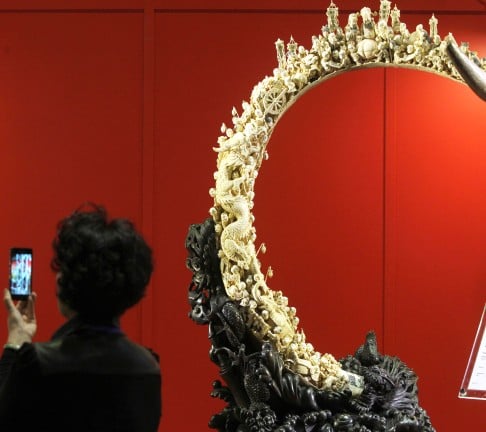Master carver uses mammoth tusks to keep 3,500-year-old art alive
Master carver turns to preserved prehistoric mammals to turn out mammoth new projects
Hongkongers have the chance to see more than 200 pieces of mammoth tusk carved by ivory master carver Chu Chung-shing and his 100-strong team at a free show at the Convention and Exhibition Centre today and tomorrow.

The elephant's protection status was upgraded from Appendix II to Appendix I of the Convention on International Trade in Endangered Species of Wild Fauna and Flora, which demands restrictions on commercial trade.
After going through a brief and tough period of transition that almost left him bankrupt, Chu turned to mammoth tusks when those long buried in the Siberian tundra came up for sale after the fall of the Soviet Union.
The highlight of the exhibition is a work entitled which was shown at the 2010 World Expo in Shanghai and is estimated to be worth about 540 million yuan (HK$680 million).
The 4.65-metre-long work was made from 500kg of mammoth tusks and features 1,000 - the Buddhist term for someone who has attained nirvana - each one carved with a different facial expression, surrounding five Buddhas.
Chu said every year his workshop in Guangdong province produced an average of 100 small works about 5cm long, each costing thousands of yuan, and three larger works valued at more than five million yuan each.
Western customers made up about 90 per cent of his buyers before the ban on the ivory trade, but now nine out of 10 of buyers were Chinese.
"The market [for mammoth tusk works] remains quite small though," Chu said, adding that it was not uncommon for some of his works to remain unsold even after he had spent as long as 10 years on a single piece.
But the master does not seem to mind as he says looking at his works always gives him immense satisfaction.
Chu said the tenfold increase in the cost of tusks - with only five to 10 per cent fit for carving - over the past decade, as well as the difficulty in attracting new blood to join the trade, had made him pessimistic about the future of this traditional Chinese handicraft, which some scholars say dates back to the Shang dynasty 3,500 years ago.
With Siberian tusks expected to be used up in 15 years' time, Chu aims to spend the next decade crafting new works and revisiting ones that are already on show in hotels.
